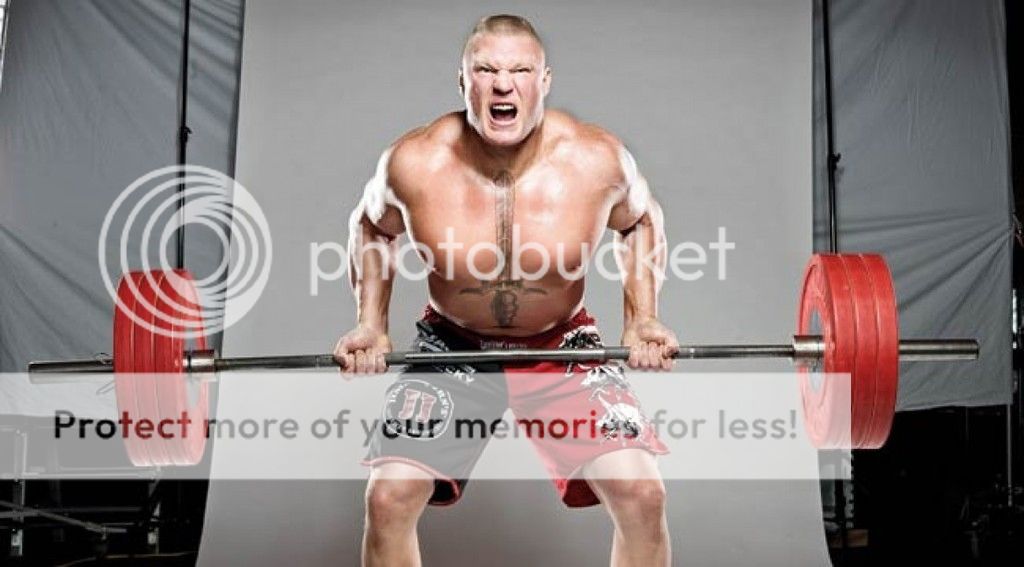Lifting Weights for Martial Arts
By Bee T. Brian
Bruce Lee, the legendary Chinese Hollywood Badass Man, once said, "You must lift weights in order to KO someone, grasshoppah!"
So obviously, there is value in strength training, because Bruce Lee said it. But even common sense and conventional wisdom speak volumes of the pure awesomeness and effectiveness of getting bigger and stronger. In fact, virtually all professional fighters of the 21st century do some form of strength training.
Like for example, Brock Lesnar.

And some MMA dude doing a one-arm overhead press with a full grown woman.

Ever since bodybuilding became a popular sport, the media put a large emphasis on training routines that looked something like this...
*Mondays through Fridays = Chest and Biceps
*Saturdays = Playing rugby with friends for "the legs"
*Sundays = Wrist curls
And it makes you wonder if these writers are trolling, because who the hell needs bigger chest and biceps if they are the least important muscles in all of sports? My theory is that an evil football warlord decided to wage war against people with lots of potential by lovely up their minds. He thought, "If everyone in the United States stopped being lazy and started doing squats, everyone would have the athletic ability of an NFL quarterback, making football lose its mystique. BRB gonna write an article about how to increase your penis length through concentration curlz."
But for every evil football warlord is a heroic weightlifting messiah...
During the 1970s, former weightlifter and powerlifter Bill Starr decided to endeavor in the world of strength coaching. And because of his extensive lifting background, he actually knew what athletes really needed: More strength. He created the Ultimate Anti-Curl Routine by putting Power Cleans and Squats in a training program. And although I haven't read nor do I own his book, I am sure it was really awesome, because his training program spawned Mark Rippetoe's Starting Strength and Madcow's 5x5.
The philosophy of Bill Starr was very simple. "Less is more, and more of less is more." By "Less", he meant "Less exercises that are potentially useless to an athlete" but "More of the remaining exercises within reasonable limit." And in those words came the birth of the American version of Bulgarian training, which was "Squat 3 times a week."
For years after the rise of his book, The Strongest Shall Survive, many coaches in many sports who believed in logic and reason, followed his training concepts. This influence carried over to the bodybuilding world, helping many men and women pack on serious size and strength.
In the world of Martial Arts however... oh lord...
Sample training program from Mega Martial Arts magazine:
*Inject lactic acid into your bloodstream...
WTF!
Thankfully, we got people like Martin Rooney, who said something very very smart.
"Stronger grapplers need to exert less effort in their moves, making them last longer than weaker fighters."
According to Rooney, real effective training programs for martial artists, or any athlete for that matter, involves actually getting someone stronger. And this includes having legitimate gains with typical "gym lifts," such as the Squat, the Bench Press, and the Deadlift.
So without further ado, here is the Ultimate Karate Training Program for the Muay Thai Fighter:
*Read Bill Starr's book, 3 sets of 10 days.
*Read Mark Rippetoe's book, 3 sets of 10 months.
*Learn about Nutrition, 5 sets of education.
*Apply what you learned in a weight room, Infinite sets of a Lifetime.
By Bee T. Brian
Bruce Lee, the legendary Chinese Hollywood Badass Man, once said, "You must lift weights in order to KO someone, grasshoppah!"
So obviously, there is value in strength training, because Bruce Lee said it. But even common sense and conventional wisdom speak volumes of the pure awesomeness and effectiveness of getting bigger and stronger. In fact, virtually all professional fighters of the 21st century do some form of strength training.
Like for example, Brock Lesnar.

And some MMA dude doing a one-arm overhead press with a full grown woman.

Ever since bodybuilding became a popular sport, the media put a large emphasis on training routines that looked something like this...
*Mondays through Fridays = Chest and Biceps
*Saturdays = Playing rugby with friends for "the legs"
*Sundays = Wrist curls
And it makes you wonder if these writers are trolling, because who the hell needs bigger chest and biceps if they are the least important muscles in all of sports? My theory is that an evil football warlord decided to wage war against people with lots of potential by lovely up their minds. He thought, "If everyone in the United States stopped being lazy and started doing squats, everyone would have the athletic ability of an NFL quarterback, making football lose its mystique. BRB gonna write an article about how to increase your penis length through concentration curlz."
But for every evil football warlord is a heroic weightlifting messiah...
During the 1970s, former weightlifter and powerlifter Bill Starr decided to endeavor in the world of strength coaching. And because of his extensive lifting background, he actually knew what athletes really needed: More strength. He created the Ultimate Anti-Curl Routine by putting Power Cleans and Squats in a training program. And although I haven't read nor do I own his book, I am sure it was really awesome, because his training program spawned Mark Rippetoe's Starting Strength and Madcow's 5x5.
The philosophy of Bill Starr was very simple. "Less is more, and more of less is more." By "Less", he meant "Less exercises that are potentially useless to an athlete" but "More of the remaining exercises within reasonable limit." And in those words came the birth of the American version of Bulgarian training, which was "Squat 3 times a week."
For years after the rise of his book, The Strongest Shall Survive, many coaches in many sports who believed in logic and reason, followed his training concepts. This influence carried over to the bodybuilding world, helping many men and women pack on serious size and strength.
In the world of Martial Arts however... oh lord...
Sample training program from Mega Martial Arts magazine:
*Inject lactic acid into your bloodstream...
WTF!
Thankfully, we got people like Martin Rooney, who said something very very smart.
"Stronger grapplers need to exert less effort in their moves, making them last longer than weaker fighters."
According to Rooney, real effective training programs for martial artists, or any athlete for that matter, involves actually getting someone stronger. And this includes having legitimate gains with typical "gym lifts," such as the Squat, the Bench Press, and the Deadlift.
So without further ado, here is the Ultimate Karate Training Program for the Muay Thai Fighter:
*Read Bill Starr's book, 3 sets of 10 days.
*Read Mark Rippetoe's book, 3 sets of 10 months.
*Learn about Nutrition, 5 sets of education.
*Apply what you learned in a weight room, Infinite sets of a Lifetime.








